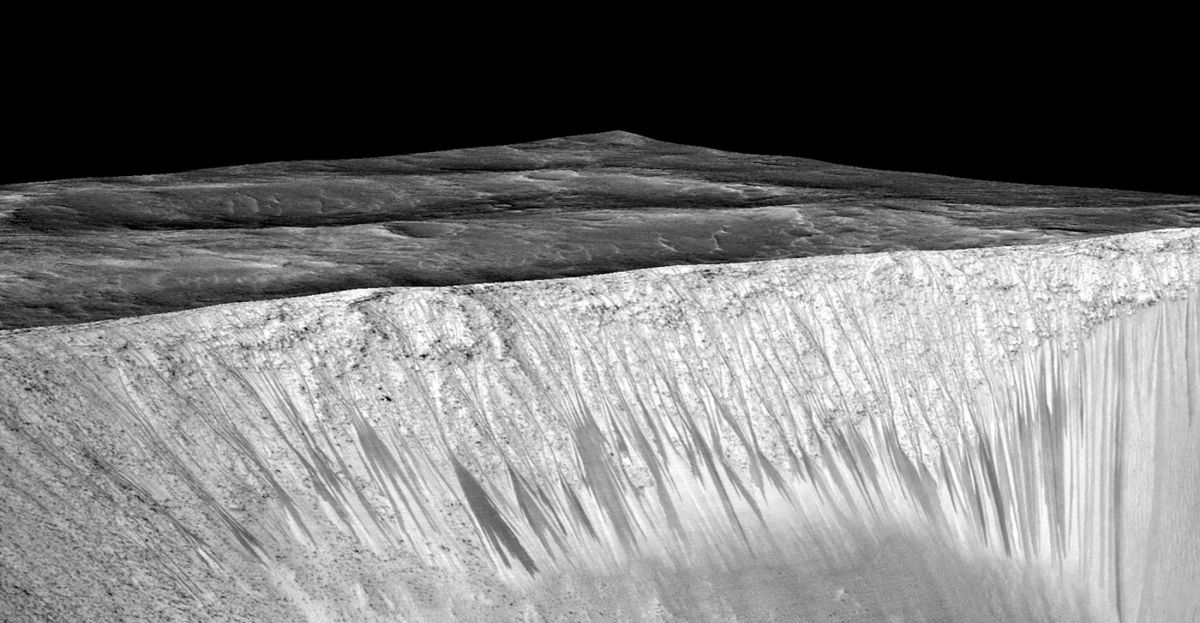
NASA scientists recently announced that hyper-saline water occasionally flows on the surface of Mars, even in the present day. The evidence is the detection of chlorate salt deposits on the surface and the association of those minerals with channel-like features on some steep slopes—channels that form, disappear and reappear at different times throughout the Martian year.
It has been known for some time that these dynamic features, which are termed Recurrent Slope Lineae (RSL), are indicative of an active geological process. The new discovery of hydrated magnesium and sodium chlorates associated with some RSLs indicates that these salt deposits come and go as well. So the "smoking gun" for water is in the deduction that magnesium and sodium-rich brines flowed on the surface on a year-to-year basis.
These are not roaring currents or sustained, flowing rivers. Rather, they are rare, episodic and low volume. They can occur despite Mars's sub-zero temperature and very low pressure because the "water" is actually dense, viscous brine.
When significant amounts of salt are dissolved in water, it drastically changes the properties of the fluid, cutting the freezing point by several 10s of degrees C. This can be observed in Antarctica, where ephemeral briny lakes remain liquid to temperatures as low as minus 58.
Realizing that aqueous fluid currently exists in the shallow subsurface revives hope that any ancient life on Mars could survive even today.
When the Mariner 9 spacecraft carried out the first global survey of Mars in the early 1970s, hopes of a habitable, hydrologically active surface were largely dashed. Cameras and infrared sensors on the orbiter revealed that most of Mars is a frozen, hyper-arid hellscape dominated by ancient volcanoes and impact craters.
But our understanding of the history of water on Mars has changed dramatically since then. Since 1997, a series of infrared instruments have been used to identify and map the composition of the Martian surface. Because infrared light interacts strongly with chemical bonds, these data can be used to identify unique fingerprints of particular minerals.
Specifically, we can identify minerals that have water in their structures. As a result, we have thousands of deposits of hydrated minerals within the ancient crust of Mars, mostly dating back to more than 3.5 billion years ago.
Understanding the mineralogy of Mars was a huge breakthrough. The results point to environments that would have been extremely wet and habitable to bacterial life at that time. This is important because it could reveal clues about how pre-biotic processes led to the formation of life on Earth.
Our understanding of the origin of life on Earth is limited, and always will be, because our planet is so geologically active that it resurfaces itself through plate tectonics. There are very few examples of extremely ancient rocks on Earth. The oldest ones contain controversial evidence that bacterial life had already formed, but because these rocks have been deformed and chemically overprinted by younger processes over time on our active planet, it is very difficult to interpret evidence for life or pre-biological processes.
But there is hope to understand early life on Earth by studying Mars. The infrared evidence for water on ancient Mars suggests that Earth and Mars were similar billions of years ago. But on Mars, plate tectonics shut down very early and the rocks from this period are well preserved. Detailed examination of these rocks could reveal evidence for life on Mars. But, whether life did or did not form on Mars, the chemical clues in those ancient Martian rocks would unlock clues to early organic chemical processes on Earth, which are not preserved.
We know that the planet was habitable early in its history and we know that it permanently transitioned to a frozen wasteland about three billion years ago. We have known that water exists as ice and permafrost in this period.
With this new discovery, we now know that localized, wet environments exist in the modern era, and therefore we can conclude that such localized lenses of salty water have existed through the period of Mars' big freeze down. Such brine patches could have served as oases of life for billions of years.
The truth is that we have no idea whether life ever actually formed on Mars. But ongoing studies of ancient environments and future sample return missions might be able to answer that question. If simple, bacterial life ever did exist there, it is not a crazy idea that it could have hung on in subsurface brines and could exist today.
On Earth, some bacteria, termed halophiles, have evolved to tolerate extreme salinity. Some will argue that the brine conditions on Mars would be too extreme, even for halophiles. But fact of the matter is that we just don't know yet.
One thing we know for sure is that, though our exploration of extreme environments on Earth, life surprises us.
Joseph Michalski is a planetary geologist at the Earth Sciences department of the Natural History Museum.
Uncommon Knowledge
Newsweek is committed to challenging conventional wisdom and finding connections in the search for common ground.
Newsweek is committed to challenging conventional wisdom and finding connections in the search for common ground.
About the writer
To read how Newsweek uses AI as a newsroom tool, Click here.





